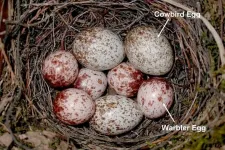(Press-News.org) COLUMBUS, Ohio - It's one thing to decide among two or three snacks available at a friend's house. But what do people do when they're faced with a vending machine offering 36 different options?
A new study using eye-tracking technology suggests that the amount of time people spend looking at individual items may actually help them decide. Findings showed that people tended to choose snacks they spent more time looking at, sometimes even over snacks that they rated more highly.
"We could do pretty well predicting what people would choose based just on their ratings of the snacks available to them. But we could do an even better job by accounting for how much they looked at each item," said Ian Krajbich, co-author of the study and associate professor of psychology and economics at The Ohio State University.
But the amount of time people spend looking at individual items isn't the whole story of how people decide when they have many alternatives, Krajbich said.
"It's a little more complicated than that," he said.
Krajbich conducted the study with lead author Armin Thomas of Technische Universität Berlin and Felix Molter of Freie Universität Berlin. The research was published this week in the journal eLife.
The study involved 49 people who said they were fans of snack foods and who agreed to fast for at least four hours before the study - to make sure the task was relevant to them.
On a computer screen, the participants were shown sets of 9, 16, 25 or 36 different snack foods and asked to choose which snack they would like to eat the most at the end of the experiment.
They did this multiple times over the course of the experiment. An eye tracker recorded exactly where they looked while making these choices.
After the experiments, participants rated how much they liked all 80 snacks that were part of the study.
The results showed that people didn't look carefully at all the items before making a choice, or even just look at each item until they found one of their favorites. Instead, they looked around in a way that at first glance looked random, but depended on the physical location of the items as well as how much they were liked.
"There is this peripheral screening process where people learn to avoid even looking directly at the snacks they don't really like," Krajbich said.
"This is not something that we see in studies where participants only have two alternatives. It only occurs when they have lots of options."
One of the leading theories among researchers is that when people are presented with many choices, they scan until they find something that is "good enough" - in this case a snack they will enjoy, regardless of whether it is their favorite.
But that's not what happened, Krajbich said. If this "satisficing" model were true, people would quit looking as soon as they found a snack that was good enough. But results showed that participants chose the last snack they looked at only about 45% of the time.
Instead, what seemed to happen most often is that people would look through the items, often going back and forth between them, until one item stood out from the others - often the snack they looked at the most.
"People made a choice when they concluded the best option was sufficiently better than the next-best option," he said.
Where the snacks appeared in the display - left or right, top or bottom - didn't play much of a role in people's decision-making. Participants often started searching in the top left of the display and then looked left to right, top to bottom - but only to a limited extent.
"Pretty quickly their attention gets drawn to their higher-value options. That influences their search process and their gaze starts to jump around less predictably," he said.
INFORMATION:
Contact: Ian Krajbich, Krajbich.1@osu.edu
Written by Jeff Grabmeier, 614-292-8457; Grabmeier.1@osu.edu
CHAMPAIGN, Ill. -- Avian brood parasites lay their eggs in the nests of other bird species, forcing the hosts to do the hard work of raising the unrelated young. A team of scientists wanted to simulate the task of piercing an egg - a tactic that only a minority of host birds use to help grasp and eject the foreign eggs. Their study offers insight into some of the physical challenges the discriminating host birds face.
The new findings appear in the Journal of Experimental Biology.
Take cowbirds, for example. Their eggs look nothing like the host birds' eggs, "yet most of their hosts do not reject the parasite eggs," said study co-author Mark Hauber, a professor of evolution, ecology and behavior at the ...
Natural disasters have a way of bringing people together to rebuild. Now, researchers reporting in the journal Current Biology on April 8 have found that the same is true for rhesus macaques.
The study reports that after a major hurricane hit Puerto Rico, macaques living on Cayo Santiago Island became more tolerant of each other and sought new social connections. The findings are based on careful study of social connections among Cayo Santiago Island's macaques before and after Hurricane Maria, a devastating storm that left more than 3,000 people dead.
"The macaques ...
Chest beating by mountain gorillas - rapidly beating their chests with their hands to produce a drumming sound - may convey information about their body size and allow identification of individuals, a study published in Scientific Reports suggests. These findings demonstrate how non-vocal behaviours may contribute to mountain gorilla communication.
Although it had previously been suggested that gorillas may beat their chests to convey information, the exact nature of that information was unclear. Edward Wright and colleagues observed and recorded 25 wild, adult male silverback gorillas monitored by the Dian Fossey Gorilla Fund in Volcanoes National Park, Rwanda, between January 2014 and July 2016. Body size was determined from photographs ...
Along the Tian Shan and Alay mountain ranges of Central Asia, sheep and other domestic livestock form the core economy of contemporary life. Although it was here that the movements of their ancient predecessors helped to shape the great trade networks of the Silk Road, domestic animals were thought to have come relatively late to the region. A new study, published today in the journal Nature: Human Behavior, reveals that the roots of animal domestication in Central Asia stretch back at least 8,000 years - making the region one of the oldest continuously inhabited pastoral landscapes in the world.
The domestication ...
Ageing and age-related brain disease do not affect women and men in the same way. The adult brain constantly generates new brain cells called neurons from stem cells, a process called neurogenesis. This process is important for learning and cognitive function which declines as the brain ages. Neurogenesis has been extensively studied in animals, but most studies have looked at male animals, raising the question of whether age-related decline in neurogenesis affects both sexes in the same way. To address this, researchers Sally Temple, PhD (sallytemple@neuralsci.org), Kristen Zuloga, PhD (zuloagk@amc.edu) and colleagues at the NY Neural Stem ...
Mutations in the DNA of the cell's energy 'factories' increases the chances of survival for people with bowel cancer, according to a study published today (Thursday) in Nature Metabolism.
Scientists funded by Cancer Research UK have found that patients with colorectal cancer, a common form of bowel cancer, had a 57 to 93% decreased risk of death from their cancer, depending on the presence and type of mitochondrial DNA mutations in their tumours.
The researchers hope that in the future, doctors could use this information to identify patients with more aggressive forms of bowel ...
What The Study Did: This analysis evaluated in-hospital mortality rates for patients with SARS-CoV-2 infection over time and factors associated with changes were examined
Authors: Lyn Finelli, Dr.P.H., M.S., of Merck Research Labs in North Wales, Pennsylvania, is the corresponding author.
To access the embargoed study: Visit our For The Media website at this link https://media.jamanetwork.com/
(doi:10.1001/jamanetworkopen.2021.6556)
Editor's Note: The article includes conflict of interest and funding/support disclosures. Please see the article for additional information, including other authors, author contributions ...
Gorillas usually stand bipedally and rapidly beat their chests with cupped hands in rapid succession. Chest beating is a unique sound because is it not a vocalization, like frogs croaking, but rather it is a form of gestural communication that can be both heard and seen. The emanating drumming sound can be heard over one kilometre away. The presumed function of gorilla chest beats is to attract females and intimidate rival males.
Researchers recorded chest beats and used a technique called photogrammetry to non-invasively measured body size of adult male wild mountain gorillas monitored by the Dian Fossey Gorilla Fund in Volcanoes National Park, Rwanda. They found that larger males emitted chest beats with lower peak frequencies than smaller ones. In other words, ...
The U.S. military veteran population is known to have abnormally high rates of suicide, so health officials have been concerned that the COVID-19 pandemic might elevate risk of psychiatric disorders, particularly among those suffering from post-traumatic stress and related disorders.
A recent national study of more than 3,000 veterans participating in the National Health and Resilience in Veterans Study did find that 12.8% reported post-traumatic stress disorder (PTSD) symptoms related to COVID-19 and 8% said they had contemplated suicide during the pandemic.
However, the same survey, published April 8 in JAMA Network Open, revealed another, startling finding. A full 43.3% ...
What The Study Did: This survey study uses self-reported data from a national study of veterans to assess the association of symptoms of posttraumatic stress disorder with posttraumatic psychological growth (these are positive psychological changes such as an appreciation of life and personal growth) among U.S. veterans during the COVID-19 pandemic.
Authors: Robert H. Pietrzak, Ph.D., M.P.H., of the U.S. Department of Veterans Affairs National Center for Posttraumatic Stress Disorder and the VA Connecticut Healthcare System in West Haven, is the corresponding author.
To access the embargoed study: Visit our For The Media website at this link https://media.jamanetwork.com/
(doi:10.1001/jamanetworkopen.2021.4972)
Editor's ...




